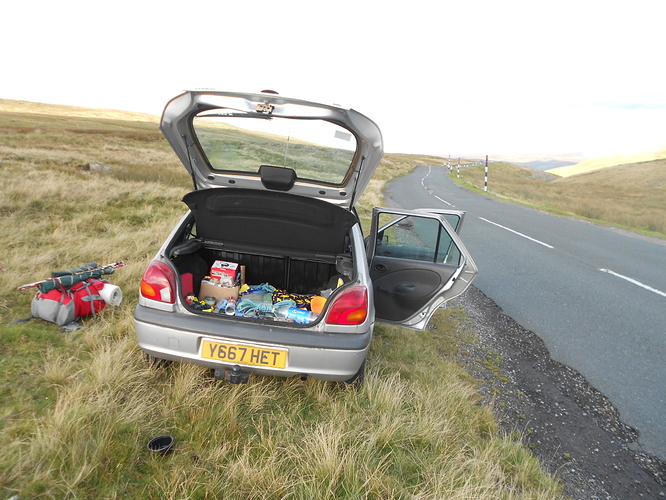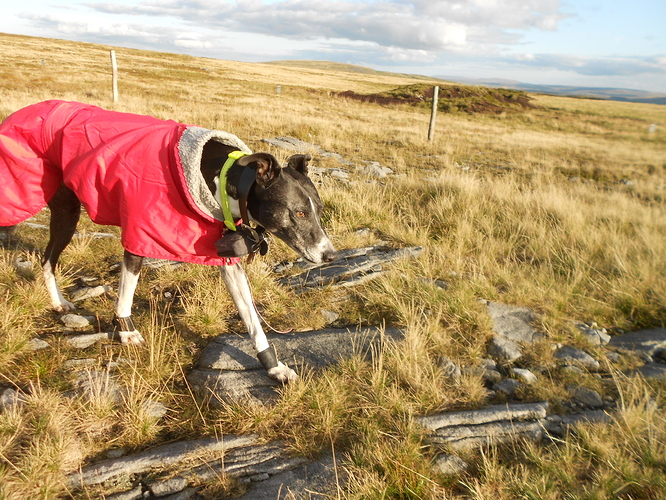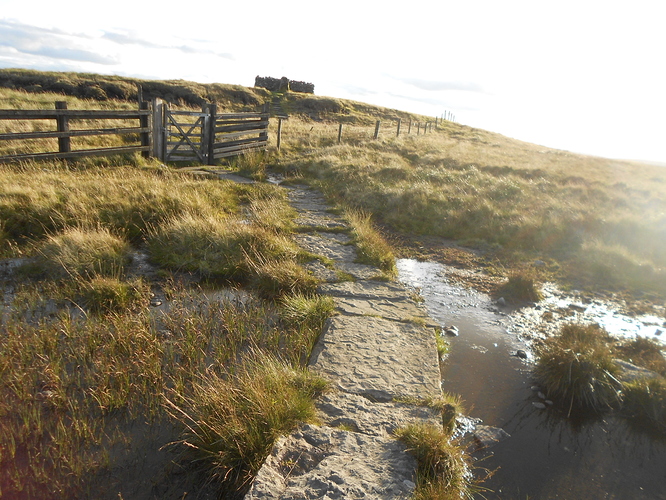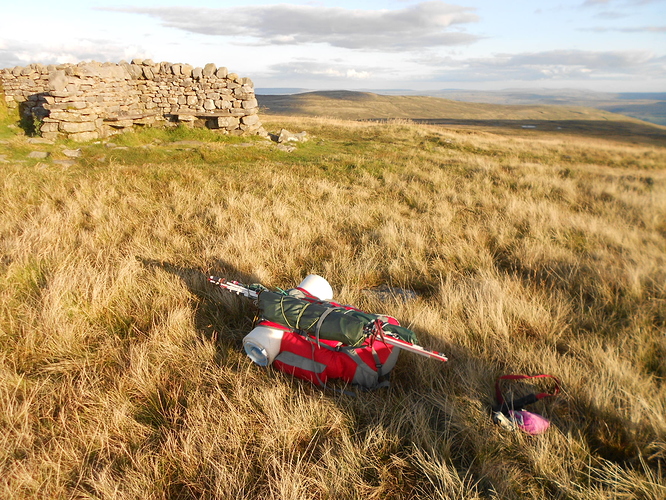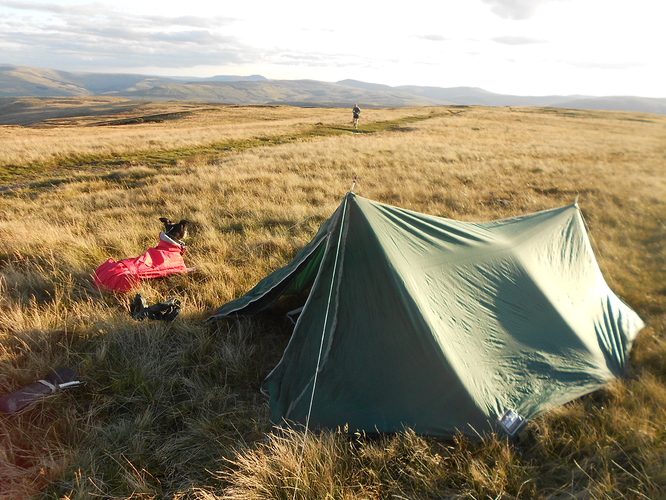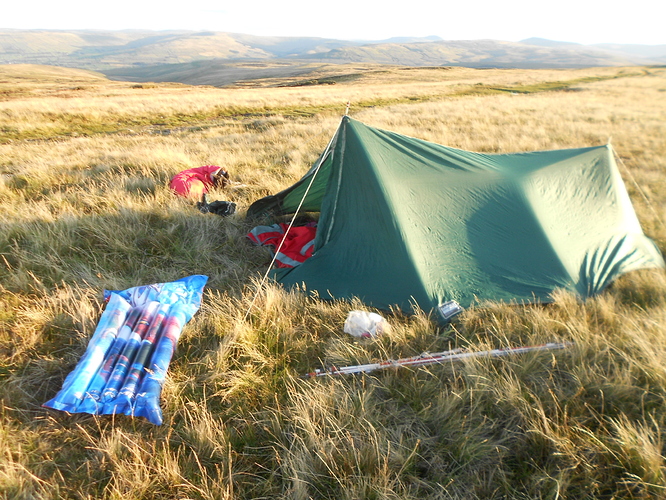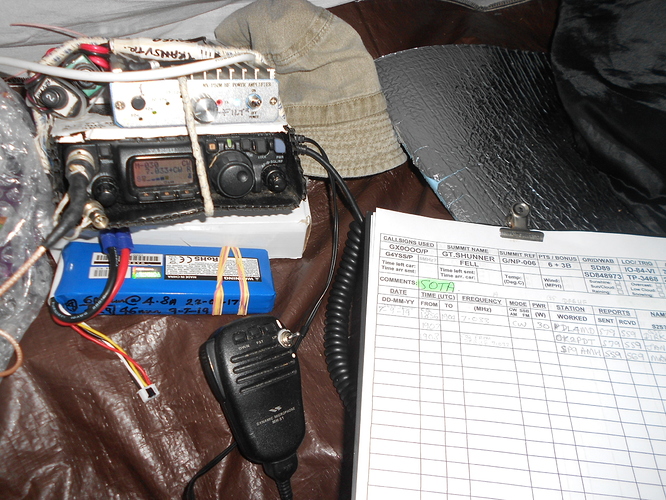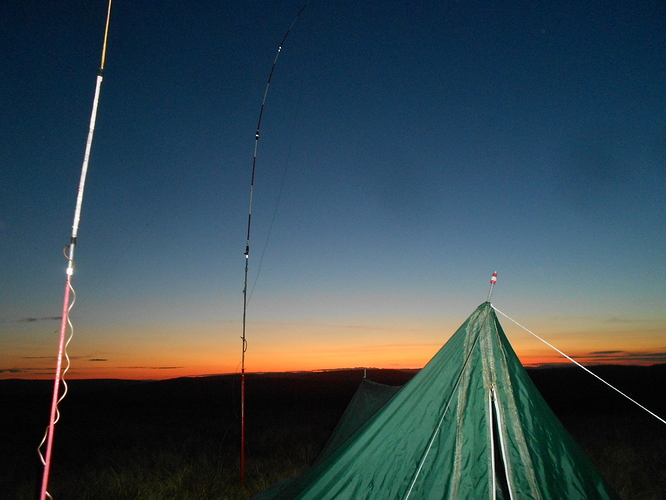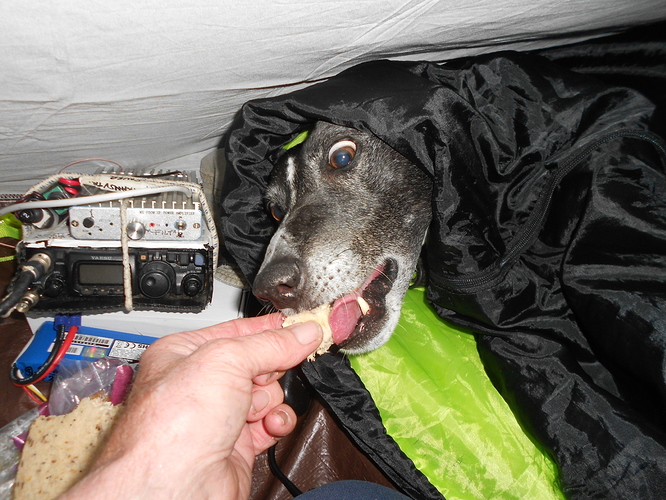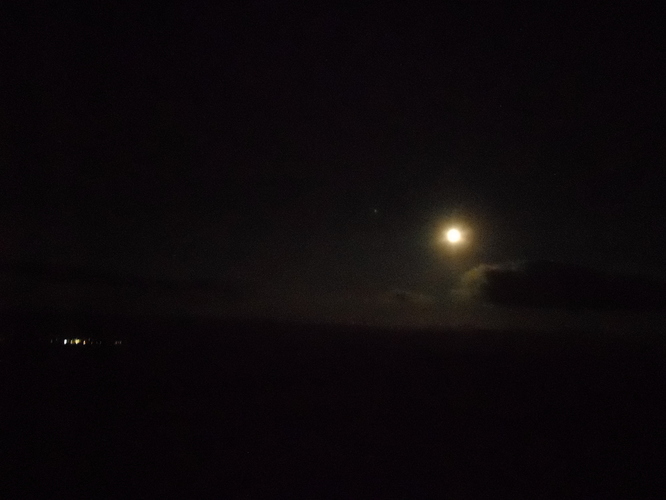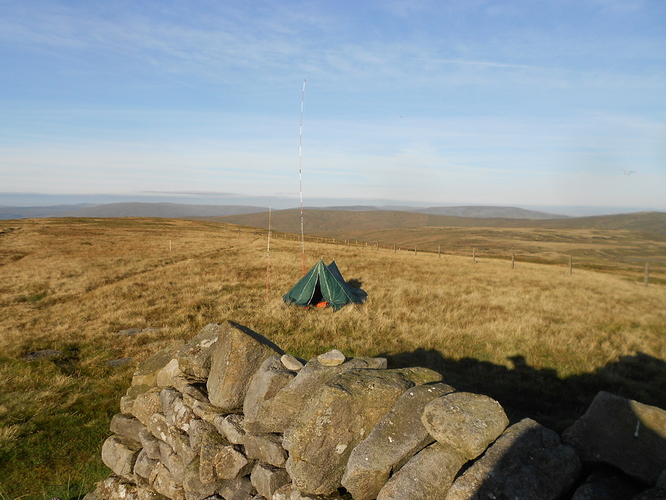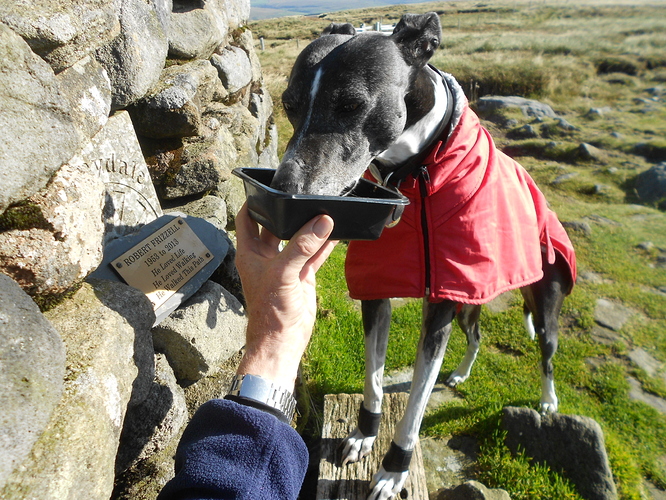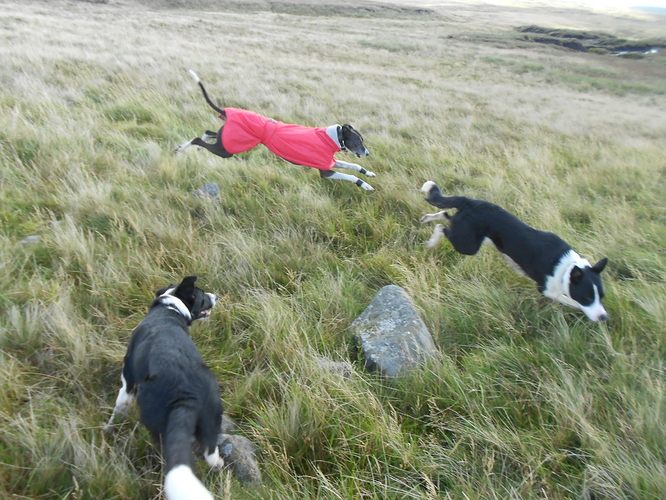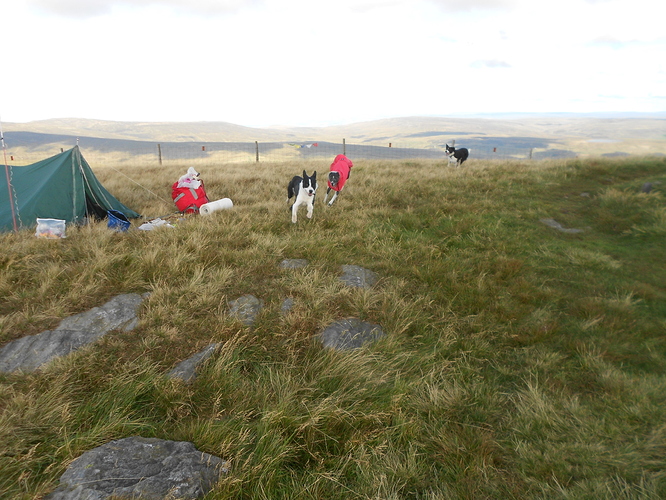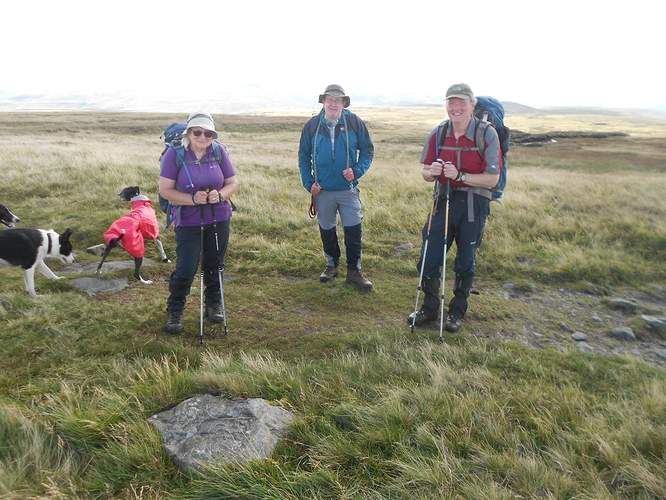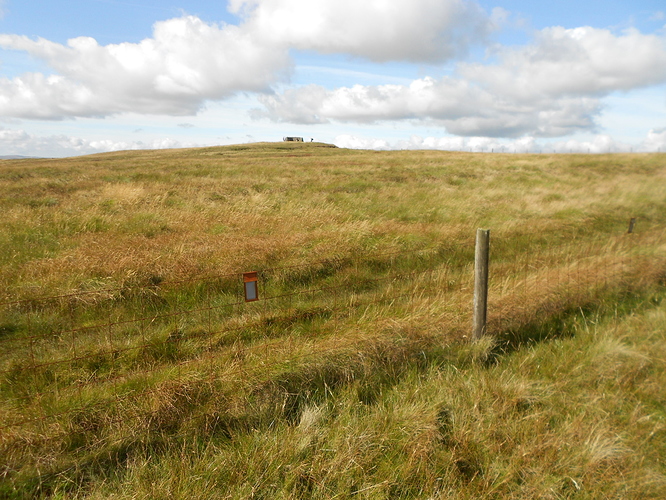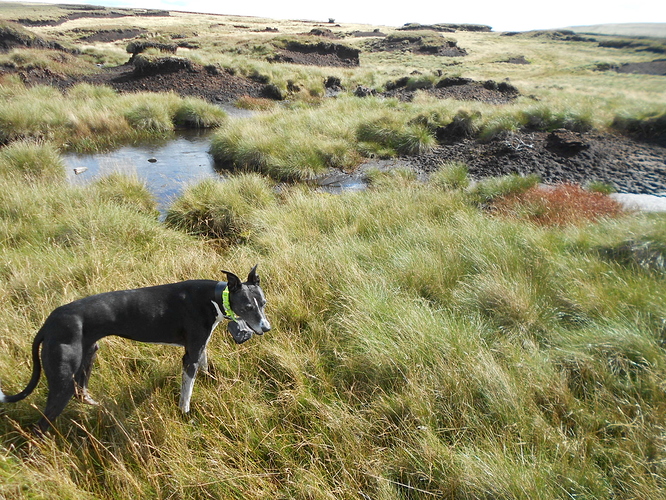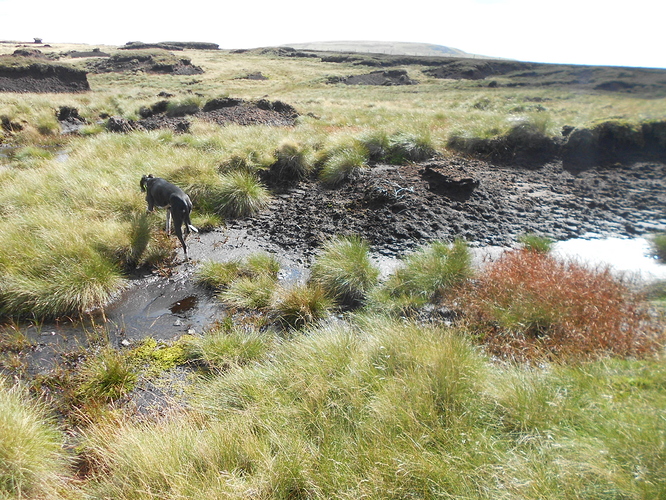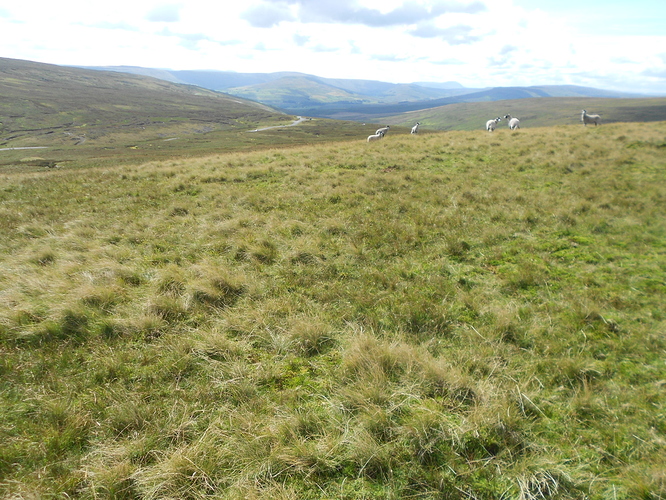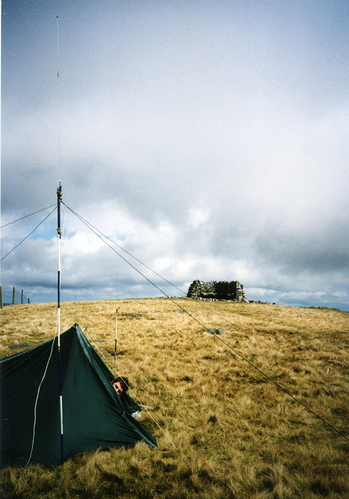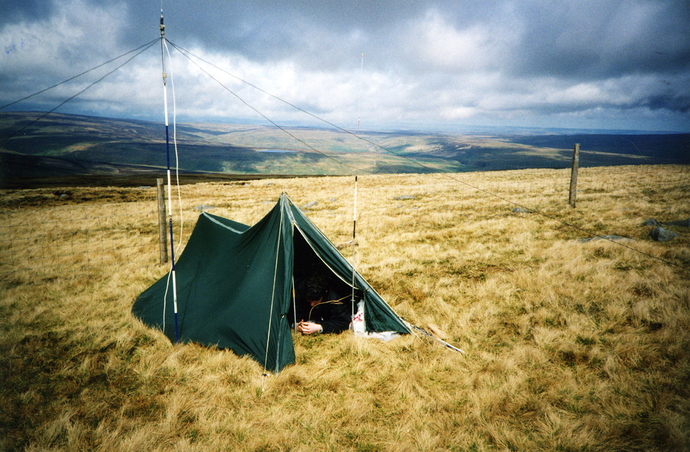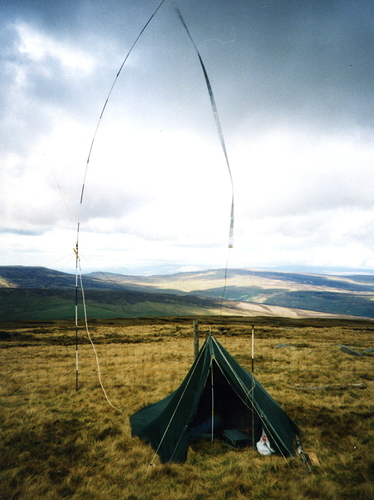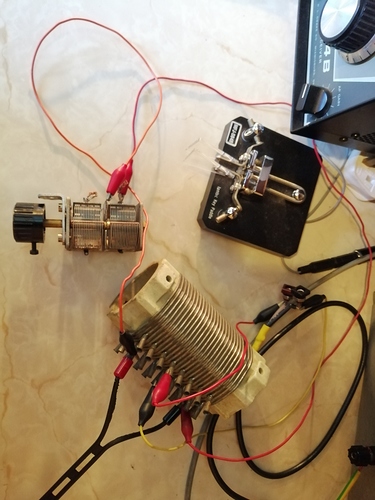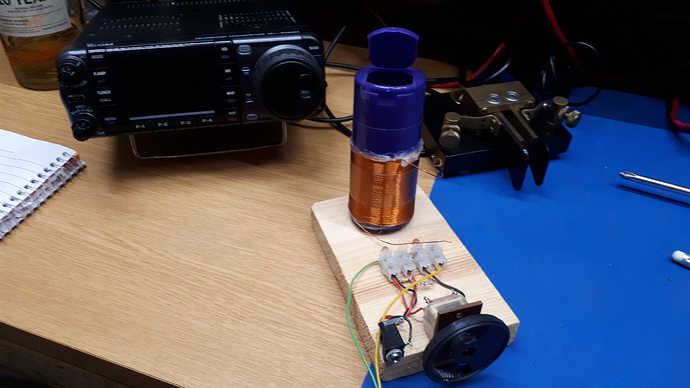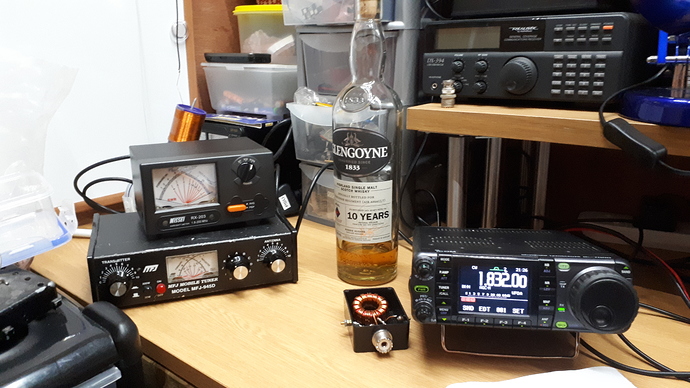G4YSS: G/NP-006 Summit Camp 07 & 08-09-19
Issue-1
G/NP-006 Gt.SHUNNER FELL on 160m-80m-40m QRO & 2m QRP
G4YSS using SSEG Club Call GX0OOO/P
Accompanied by Sasha (Grandson’s Lurcher)
7th to 8th of September 2019
This expedition was broadly similar to G/NP-011 (Gt.Coum) camp-over in 2018
Times:
BST (UTC+1hr) for walking etc.
UTC for radio operations (denoted ‘z’)
Sun Times: 06:30 & 19:40 BST
EQUIPMENT:
FT817ND HF/VHF/UHF 5W Transceiver
MX-P50M HF 50 Watt Linear Amplifier (80 thru 10) with 160m capability
Adjustable link dipole for 80-60-40-(30)-20 with loading coils for 160m
6m home-brew CFC 5-section mast with 1m end sticks
Two Turnigy 11.1V, 5 Ah Li-Po batteries
2m Band Vertical J-Pole on 1m carbon rod
Reserves:
Turnigy 11.1V, 2.2 Ah Li-Po battery (not used)
IC-E90, 4-Band VHF Handheld with 1.3Ah battery (not used)
Camping:
Viper-2 Ridge tent (inc Fly & Inner; 1988/ 2.2kg)
Sleeping bag 1.2kg Mtn. Eqpt. Nova-2
Sleeping bag 0.7kg synthetic (Dog)
Sleeping mat full length
Sleeping mat half length
Spiderman Airbed (Grandson’s) 116 x 62cm, 340gm
Goretex Bootees worn for use when leaving the tent
Pack-weight: 17.5 (38.6 lbs) inc. 2.5 ltr fluids
Other:
Garmin Geko 301 GPS
DAB Cube for Ashes Test Match (we lost)
INTRODUCTION:
G/NP-006 was chosen from a sizable selection of NP’s remaining this year. In fact too many due not enough bonus grabbing in winter and my usual neglect through the summer months.
Great Shunner Fell is a 6-pointer and though it’s a fair walk, it can be accessed from Buttertubs Pass at 526m ASL. This is an important feature when camping, due to the load carried. The downside is the surface as the path runs through the aptly named ‘Grimy Gutter Hags.’ However, once climbed there’s a grassy top to camp on and plenty of space for a big dipole. There’s a trig point to offer WAB members as well as the grid square. Another consideration was that NP6 was yet to appear on my list of SOTA’s camped on but in terms of radio, Top Band was the primary reason for this overnighter.
Sasha, my Grandson’s Lurcher was going too so there would have to be adequate dog food, water and treats including small cubes of corned beef and a can of sardines. When she knows I have these items there’s a better chance of her coming back in case she should run off. If that should happen she wears a 100mW transmitter round her neck, at least for walking up and down.
WEATHER - MWIS mountain forecast at 600m ASL:
When it comes to camping high in any season, the weather prospects are more critical than for a single day SOTA when only one weather window is required. Finding two consecutive good days was a third time lucky affair as I have had to cancel my plans for two VHF contest evenings from NP6; namely the 4m one in August and the 2m one on 3rd September. The MWIS Dales forecast predicted a wind of 10mph with a daytime temperature 6 to 8C, sunshine and no rain and you can’t say fairer than that.
NP6 ROUTE:
Follow the quad track all the way. Though it’s ill defined in places, it loops round via Coal Pit, Grimy Gutter Hags, Grainy Gill Moss and Little Shunner Fell. It’s best not to take a direct line from car to summit as I have done twice in the dim and distant past due to ignorance. There’s plenty of bad ground on the track but going cross-country is much worse and should not be considered.
From SD 8688 9570 on Buttertubs Pass, the track goes up via Coal Pit to the fence corner at SD 8694 9639 (turn left). The fence bends again at SD 8680 9653 at Grimy Gutter. There’s another direction change - left (WSW) at SD 8586 9707. The track passes the end of a wall at SD 8542 9687 and after some steep sections you eventually reach a stile (optional) at SD 8503 9723 not far short of the summit. As of 2019 the latter has fallen apart so it’s worth carrying on beside the fence to the Pennine Way, turning left there and passing through a gate a short distance from the summit. There’s only 200m of ascent but it’s a longish slog (2.2 miles) considering the wet ground and three moderately steep sections.
EXECUTION:
Leaving Scarborough at 14:35, we arrived at Buttertubs Pass for 17:00 (82 miles); parking on the grass verge where the track goes off left at SD 8688 9570. After Sasha finished her tea, we got walking at 17:30, in pleasant conditions. She’s OK with sheep but it wasn’t long before the lead had to deployed, there being a lot of rabbit holes on the section up to Coal Pit. The journey today took 56 minutes which considering the weight carried was not that much longer than normal.
As expected, the summit was deserted and it was a sunny evening with great views. After planning where the antenna would fit in, no amount of walking to and fro got us a good pitch for the tent. It looks flat enough from a distance but close-up there are plenty of undulations hiding under tussocky grass. In the end I threw the tent down and got to work while Sasha explored the summit area and shelter, about 25m away.
A 1998 Activation:
As an aside, the last time I erected a tent on Gt Shunner it was just for the day when my son Phil G0UUU and I logged 25 contacts on 2m, 4m, 6m & 70cm (all FM) on 4th of May 1998. On that occasion we used a handheld for 2m with a vertical but for 4m it was a converted 40W Yaesu mobile PMR and a tape J-Pole. I can’t remember what we had for 6m; probably a Palstar H/H to a g/p. Looking back at the log I see that we worked Geoff G0WHA and Simon M1AVV, both now well known SOTA ops. Six hours of operating and four years pre-SOTA.
Setting Up:
I allow an hour or more to get everything sorted the way it should be but at least today there were no beams to assemble. The HF dipole and 2m-FM vertical were set up on the south side of the tent. The first job was to tune the 160m coils but I noticed that Sasha was busy trying to dig down into the grass. Despite her coat this is a sure sign that she’s cold and with the sun on the way down and a cool breeze, I could understand it. Once tucked into her sleeping bag she was more than happy to stay there until morning.
G/NP-006 GT. SHUNNER FELL, 716m, 6 pts. 18:26 on Saturday 7th to 11:51 on Sunday 8th Sept 2019. Approx. 10C dropping to 4C at night. Wind 10mph dropping to zero at 4am. Sunshine & moonlight. IO84VI, WAB SD89. Trig: TP-3468 (integral with shelter). Weak Vodafone signal.
Evening of 7th September 2019:
7.033 CW – 3 QSO’s from 18:56z:
With the first alert posted for 9pm local there was time to insert something extra into the programme but what? A listen on 20m did little to inspire me so I chose 40m CW, hoping to give Europe their best chance. A self spot on Sotawatch preceded my CQ.
Stations worked: DL4MD Dirk nr. Stuttgart; OK2PDT Jan and SP9AMH Mariusz. Power was set to 50 Watts throughout but disappointingly the frequency quickly dried up to be followed by a CQ from DF6UF who evidently hadn’t heard my ‘QRL.’ After trying a few more CQ’s in conjunction with the interfering station I gave up; neither of us having any success.
3.778.6 SSB - 6 QSO’s from 19:57z:
From switch-on I could tell that the band was very busy indeed. 3.760 was the intended target but it had on it a strong station calling ‘CQ Contest.’ Ah yes, now I remember. Wasn’t this what was being discussed at the Scarborough Amateur Radio Society meeting on Monday evening? The club chairman Conrad was offering his low-noise QTH at Staintondale for the NFD contest and inviting members to operate. (I later discovered that they ended up with 517 QSO’s).
Finding a spare frequency in this mayhem was not possible and I was forced to shoe-horn in between two of them, suffering the consequences as a result. Canceling this alerted band/ mode combination was not an option as I didn’t want to disappoint chasers. My son had kindly put an alert on the WAB reflector for me but there was scant chance of them finding me now, up band as I was. Maybe I wouldn’t be heard at all but a self spot was successful, giving me a chance. A year ago Roy G4SSH would have been helping me but in the rest home where he now lives, he has no access to a radio or computer.
With some difficulty in the heavy QRM, the following stations managed to bag the summit and/or the WAB square: GM3BSQ/P Norman operating the Aberdeen club station (Ser No’s 001/ 119); M0SDE Tony in NZ22 Shildon; G4BP/P SARS NFD station - op Dave (Ser No’s 002/ 233); M0BKV Damien in Cornwall; G3TQQ Dave SARS member/ SOTA activator in Pickering and last to call in, G4AZS Adrian reporting ‘Heavy QRM.’
Power remained at 50 Watts throughout; anything less would have been ill judged in the conditions you’d have thought, with splash from both sides but surprisingly all reports in and out were 59; SARS even giving me 59 plus 20dB. Obviously the band was propagating mightily well which tended to counter the QRM but I would not have liked to try this with QRP.
The session spanned 40 minutes – a long time but that included a 10 minute phone call from Phil G0UUU. We were discussing the contest to say nothing of the cricket but even if I’d twigged beforehand that it was NFD, it would have made no difference. Having missed out twice, this escapade was 90% decided on the basis of a good weather forecast and Top Band.
3.557.7 CW - 9 QSO’s from 20:48z:
Ah, what a contrast from SSB. It seems that NFD must have been SSB only, meaning respite was to be found down the band. Even so I had to shuffle up a few hundred Hz from the alerted QRG to dodge a CQ’er.
After another self spot, I worked a steady stream of chasers: G0HIO Mike; EI6FR Declan in Dublin; M1BUU Colin; HB9CMC Fred; PA9CW Tonnie; G0BPU Mike; M0HTE John; GW4VPX Allan and OH6KSX. Colin happened to be in the shack doing some work when he saw the spot. This led me to the conclusion that I hadn’t alerted early enough – again!
Outgoing reports were 599 apart from John who I struggled with in QSB; 449 being generous. RST’s coming back were 579 to 599 with a 559 from Finland. Power was dropped to 30W for the 12 minute session; much quicker and more efficient than SSB for obvious reasons and that despite repeats due to my CW toggle switch sticking on occasions. It must be time for the switch cleaner so apologies for the poorer than usual CW.
1.832 CW - 6 QSO’s from 21:08z:
Traditionally taking place at 11pm BST, this was alerted for 10pm due to the nights drawing in a little. It was good and dark by now anyway, which is the main consideration and the earlier time might suit chasers better.
I was nearly 10 minutes late but Mike G0HIO was first to hear my CQ in Burton-on-Trent. I got 549 in exchange for the 579 that I gave him. He may not have been as strong as that. I use a headlight and to save power when portable, switch off all the back-lighting. That makes it hard to focus on the meter in the short time available, especially when simultaneously writing in the log.
Some say to use the ears and not the meter so despite not necessarily buying into it, I’ll use that maxim as an excuse for possible inaccuracies. When crouched in a tiny tent on a dark summit, to my mind if we get some confirmed numbers in the log at both ends then the actual values are not desperately important.
Next in were GW4VPX Allan 589/ 558; M0BKV Damien 599/ 559; G4AZS Adrian 2 x 559; G4IPB Paul 30km to the NE and 59 both ways, followed finally by M1BUU Colin, somewhat of a struggle with 339’s but well worth the effort.
Known to air it from SOTA summits, Colin rigged something up at short notice to cover 160m from the shack. This consisted of a length of wire and some components including a coil robbed from an old crystal set. The ingenuity of the lad! He wasn’t remotely strong but we did get the QSO after a few repeats. In the end, that’s what counts.
From memory I think Adrian told me earlier on 80m-SSB that he currently had nothing in the way of an antenna for Top Band. Like Colin, he must have come up with a solution in a hurry for what I think is his fourth 160m QSO with GX0OOO/P. It wasn’t easy in QSB and the noise but Adrian is another who proved that success is possible if you ad-lib a little. Interestingly, I have a record of a rare Top Band daytime S2S in CW with Adrian during the solar eclipse in 2015. (G/TW-004 to G/WB-015).
Power was 50 Watts, the maximum available and the session spanned 23 minutes.
1.848 SSB - 5 QSO’s from 21:40z:
There was a strong signal on 1.846, the alerted frequency so I had to squeeze between two stations again. This time I was spotted by Paul G4IPB.
Continuing with 50 Watts, I worked the following callsigns: G4IPB Paul - Middleton-in-Teesdale 59/ 57; G0JLA Rod in Hereford City 55/ 35; G3TQQ Dave in Pickering N.Yorks 57/ 55 and DL5AV Mike 2 x 57. Last in was G8ADD Brian in Birmingham with 55/ 55 and later 57 in QSB. Working these QSO’s took just over 15 minutes which isn’t bad considering the QRM, QRN and QSB.
I was hoping to work G1YFF Jake who is a keen WAB operator and 160m enthusiast. After Phil’s alert on the WAB reflector, he would certainly be listening but I know he suffers from appallingly high noise on 160m. Nothing heard I’m afraid.
The first 5Ah Li-Po Battery failed during the QSO with Paul at the beginning of this session and was changed for an identical 5Ah.
145.550 FM – 2 QSO’s from 22:17z:
Partly because it had been such a struggle on 80m-SSB with NFD stations and also because it was a little early to retire, I had a tune round on 2m, noting more activity than expected.
A CQ on S20 brought in Chris 2E0XLG/P portable at Tan Hill. With one end at 2,350 feet and the other, as I remembered at 1,732ft ASL and not many miles away, signals were very strong. I got 59 plus 30dB from Chris, who I’ve worked before. He was having a good laugh at bagging a SOTA this close to midnight. ‘I might have know it’d be John,’ said he lightheartedly. Chris reported that Kevin M0XLT was now home, post-op and was recovering well. My best 73 to Kevin in Gargrave, if he reads this. Get well soon!
After a good chat with Chris, M1DHA Alan called in from Barnoldswick with 59 both ways. He was using an IC706-2G coupled to a big amp and a ‘white stick’ as he called his antenna. This covers 6m, 2m and 70cm and Alan had been following my spots round the bands all evening.
Power for these two QSO’s was initially 5W from the FT817ND but at some point I turned it down to 1W which was still much more than required.
The NIGHT:
All that now remained was to remove the 160m coils in readiness for 80m in the morning and have something to eat. It was predicted to be a cold night but I wasn’t too concerned about that with the wind speed gradually dropping. However food is fuel and it would help both the dog and the op to keep warm for the next 8 hours or so.
What a privilege it is to stand on a SOTA summit at night and look up. With an absence of cloud all the stars were visible along with the partial moon and the lights of Hawes down and to the south. The coils were playing hard to get but reflective tape helped.
It’s difficult to sleep well when you’re bent to the shape of the ground, in my case too low at the head end. An inflatable pillow helped but I never did manage to get truly comfortable, unlike Sasha who’s bed was in a slight depression. The last time she drew the short straw and ended up on a hump. She was all over the place by morning.
At 4am the wind had dropped to zero with not even the tent cloth rustling. Before that a very slight breeze made the wires above us ‘sing’ softly. At around 05:50 it began to lighten and you could hear the odd Red Grouse calling out. It sounded exactly like, ‘Get out, get out, get out’ but we weren’t having any.
After more wakefulness than sleep we ‘slept in’ until 08:20, ten minutes before QRV on 80m-CW. It hadn’t felt particularly cold in the night but I later learnt from a visitor to the summit that there’d been a frost in the valley below, perhaps the first one of the autumn. All we had on the summit was sunshine and a light dew.
Morning of Sunday 8th September 2019:
3.556 CW – 5 QSO’s from 07:35z:
One kHz down from the usual channel to avoid a QSO, I called CQ with 30 Watts and soon identified Damien M0BKV coming back. Nevertheless I asked for a repeat so I could look at the meter which read S8 resulting in an exchange of 589/ 579. Following on from Damien was Colin M1BUU with identical reports.
Allan GW4VPX was in next with 589 to 599/ 599 and afterwards there was a call at great speed. I can’t read CW at over 30 WPM so I asked for callsign repeats and eventually wrote down ‘M6MPC.’ This turned out to be Mike in Tintwistle, gleaned later from QRZ and we exchanged reports without problem at 589/ 599. An extended over ensued in which I managed to read absolutely nothing apart from ‘QTH.’ In case that was a request I sent the location, hoping the embarrassment would soon end. I really need to sign up for Scarborough Club’s Monday evening Morse lessons to try and get my speed up but I fear you can’t teach an old dog new tricks.
Tonnie PA9CW rounded the session off with 589/ 559. All stations were worked with 30 Watts and logging these five took 15 minutes.
3.763 SSB – 12 QSO’s from 08:00z:
The Worked All Britain frequency of 3.760 was busy but as far as I could tell this was not WAB so I moved up three kHz and self spotted with the phone.
30 Watts brought in the following chasers and the nearest thing to a pileup of the weekend: EI7T/P Paul - Tipperary; G4OBB Des TL84 Suffolk; 2E0FEH Karl Saltash, Cornwall; G7LMF Graham in SJ61 Telford; G0VWP Terry in York; G0ELJ Dave TQ51 Norfolk; MW6IUT Bryan - Neath ; M1BUU Colin in Bentham; M1TES James in Bungay; GW0TAU Paul – Swansea (SS69/ Book No 7362); G0RQL Don in Holdsworthy, Devon and GI0AZA Esther in Londonderry.
I took the opportunity to congratulate Esther for having helped in an emergency using radio. Many may already know about this but there had been a road accident in an area where there was no mobile phone coverage. A description of the event appeared in a recent Radcom, which can’t do our hobby any harm. Ian was unavailable at that early hour. They had been to an Ireland/ Wales rugby match the night before.
Colin and I had a brief discussion about the Top Band contact of the previous evening, which we were both pleased to have made as this was the first time we’d worked on 160m.
Reports were all between 57 to 59 apart from Colin 56/ 51 and 55’s from Karl and Bryan The session was over in 25 minutes.
At 08:09 I heard ‘G0N??’ but after trying to bring this caller in for a long time and also later on, I had to give up without hearing anything further. I think this could have been Don G0NES. It sounded like his voice in the short snippet I heard and he is a long standing SOTA chaser. I assume the caller, whoever he might have been, was suffering severe noise and QSB. Nothing unusual about that these days!
After this I started clearing up but then had second thoughts, ‘What’s the rush?’ Maybe I should give Europe another chance so opening the 40m links I found 7.033 to be clear.
7.033 CW – 9 QSO’s from 09:08z:
A self-spot appeared to ‘take’ and the frequency rapidly became alive. ‘Oh no not another pileup’ and in CW. On the one hand the callsigns often add together to make a single steady note due to the accuracy of modern VFO’s and on the other hand my toggle switch was sticking, resulting in extra dots and dashes. No stranger to this kind of embarrassment, I soldiered on with the following stations logged:
ON4FI Karel; F8FSC Larry; ON9CBQ Franz; PA1BR Pascal; IK2LEY Fabio; SM4CJM Hans; SA4BLM Lars; PA0B Rob and EI5HJ Gary. Outgoing reports were in the range 579 to 599 with two 559’s. In response to my 50W signal I got back 529 to a maximum of 559, with a 339 from Italy, a 449 from PA and 419 from Eire. By the time the frequency dried up it was 09:20z which still left time for a last try on 2m.
145.550 FM – 2 QSO’s from 09:30z:
Starting with a CQ on S20, this was more or less a repeat of the previous evening with the same stations reworked. Chris 2E0XLG/M mobile this time between Tan Hill and the A66 responded first.
M1DHA Alan - Barnoldswick, was the final contact of the expedition with 59 both ways once again. A self-spot and two returns to the calling channel brought nothing further which I took as a sign to pack up and leave.
Sasha had been lying on the grass in her coat sun bathing since the beginning of the 40m session but suddenly went chasing off along the path which comes up from Hardraw. A man was approaching from there with two beautiful short-haired Border Collie dogs. He turned out to be from Stanraer and his dogs, Victor and Jack (both good SOTA activator names, I noted) were just a year old. Their owner was happy to let them mingle and so we did. Though the result was boisterous to say the least, Sasha’s corned beef cubes went down well with the guests. The Scott was out for a stroll having climbed every Munro in his lifetime so we compared notes quoting the few I’d done.
Presently a couple turned up. Huddersfield people, they had big packs with camping gear and seemed to be doing the PW, whether all of it or just a part was unclear but they asked about the antenna; me giving the usual explanation. They went off heading north for Muker, the man and his collie dogs taking the path back to Hardraw. It took another half hour to finish dismantling the encampment but by 11:51 we were on our way down.
DESCENT:
The walk down was mainly in sunshine with a nice cool breeze and we reached the car in 47 minutes at 12:38. Half way down I turned round to check on Sasha but she’d vanished. Panicking and quickly switching from cricket on DAB to VHFM, I could hear her but she was nowhere to be seen. This was just what I didn’t need, miles from anywhere but then I saw her way back and running towards me probably having been on the trail of some rabbit. It’s a worry when instinct overrides training. Once she was gone for almost an hour but that happened near home.
I thought it prudent to put the lead on for the final rabbit infested section where sheep were also grazing. It was a relief to sight the car. After a night out, there’s always that niggling doubt as to whether it’ll be where you left it. Not that anyone in their right mind would want to pinch my vehicle but it did happen once. A ten-quid 1959 Standard Ten went missing from outside the house in 1974. It was found across the middle of a cul-de-sac by the police. As luck would have it the starter bendix had jammed into the ring gear and the thieves had done a runner.
Drive Home:
I took the back road to Leyburn via Askrigg, catching up just one car on the way. From there it was the usual Thirsk, Sutton Bank and Pickering route while listening to England trying (but failing) to save the ashes on a new DAB adapter bought for my recent 70th birthday by my son. There was less traffic than expected so Scarborough was reached at 15:07. First job: Kettle on and two pints of tea!
QSO’s - 59 comprising:
4 on 2m-FM
14 on 80m-CW
18 on 80m-SSB
6 on 160m-CW
5 on 160m-SSB
12 on 40m-CW
Days/ QSO’s:
31 on Saturday
28 on Sunday
Breakdown:
CW: 32
SSB: 27
FM: 4
Battery Utilization (Li-Po’s):
5Ah No1: 100%
5Ah No2: 80% (tested)
Total used: 9Ah
Ascent & Distance:
200m (656ft) ascent, 7.1 km (4.4 miles) 2.6mph
6 SOTA points
Walking Time: 1hr-43 min.
(56 min up/ 47 min down)
Summit Time: 17hr-25 min
Home to home: 24hr-32min
Distance driven: 165 miles
Chronology (BST):
07-09-19:
14:35: Left Scarborough (E.Ayton Garage)
17:00: Arrived Buttertubs Pass (A170/ A684)
17:30: Walked for G/NP-006
18:26: Arrived G/NP-006
08-09-19:
11:51: Left G/NP-006
12:38: Arrived car
12:55: Drove for home
15:07: Arrived Scarborough (via Askrigg, Masham, Thirsk & Sutton Bank)
DISCUSSION:
Because there was no requirement for VHF beams/ transverter etc, the all important pack weight was kept below 40 pounds. Not so painful.
There were fewer contacts than on some previous summit camps, partly due to the difficulty of operating on 80m SSB because of NFD contest stations. This helped CW to win the QSO count.
160m:
For me the prime band, 160m delivered 11 QSO’s, ten of which were within the UK. The one European station was DL5AV and Mike was easily worked with 57 both ways. My late alerting was probably the reason that more overseas stations were not worked.
It’s worth mentioning the enthusiasm of SOTA 160m chasers again and the way they strive to come up with ways and means to get onto the band. The average British garden will not contain an 80m antenna let alone a 160m one but that doesn’t stop chasers lashing something up that’ll do the job.
80m:
The 32 QSO’s on 80 made it the top scorer as usual but putting a SOTA activation with all the activity from NFD stations was a challenge. The hope that a run down the WAB net would yield lots of quick contacts was a forlorn one but to be fair 9pm was getting late for WAB’ers to be operating even with ‘normal’ band occupancy. NFD wasn’t all bad news however. Two contesters answered my CQ’s, one being Scarborough Amateur Radio Society station G4BP – a call I’ve used myself from summits.
40m:
Due to the NFD-SSB contest, only CW was used on here. Up to five years ago a CQ on 7.032 would be all that was required to fill half a log page with SOTA contacts but that’s no longer the case in 2019. That fact makes self spotting much more important. The reason for going on 40m was to reach chasers in Europe.
2m-FM:
There were just four 2m-FM QSO’s with two ops over the two days. VHF lost out to HF but 2m is not what it was. At the last two SARS meetings, the 2m band was discussed and we resolved to try to use it more. The immediate threat to it has receded but there may be others in the future.
WX:
Perfect – nothing more to be said.
Mobile phone:
Vodafone supported texts, self spots and one phone call but only just. The signal was mostly one bar and often nothing on the meter. Occasionally you would get three bars and I saw ‘4G’ flash up a couple of times. Half of my spots ‘came back to me’ but many were not seen on the screen afterwards.
Camping:
This was my 18th summit overnighter for SOTA and Sasha’s fourth. It seems that it’s a branch of the hobby I enjoy and the routine is well established by now. Though some of the equipment is old and probably looks it on the photos, particularly the tentage, I wouldn’t like to change. The main reason for that is the time it takes to erect. Because the flysheet is pre-assembled with poles and pegs it can be up in quick time. Furthermore it’s carried on the outside of the rucksack meaning nothing needs to get wet in the rain, blow away etc. Once the fly is up you can relax as the inner tent can be pitched inside it.
Sasha:
Apart from a couple of minor lapses, Sasha was good and as usual a great companion. She chose to stay in her sleeping bag for 12 hours but she can be completely trusted not to damage anything in the tent. She did get between me and the radio a couple of times during QSO’s but she’s not clumsy, instead delicately treading to avoid the equipment. It wasn’t all boring for her. She had a really good chase around the summit with the two collies and enjoyed some of the special treats brought up for her.
The day before the expedition Sasha, now aged 10, was at the vets being diagnosed with possible Megaesophagus. It means that she has difficulty in swallowing food properly so now her front end must be elevated at feeding time. On Great Shunner Fell one of the wooden shelter benches came in handy to put her front paws on for breakfast.
THANKS:
Thanks to ALL STATIONS WORKED. Many thanks to the ops who came up late for Top Band. Thanks also to spotters: G4IPB; G0HIO and the SOTA phone-spotting ap. To Phil G0UUU for alerting the WAB group. Finally thanks to Sasha – she was great company again.
73 John G4YSS (Using SSEG Club station callsign GX0OOO/P)
Please report errors…
